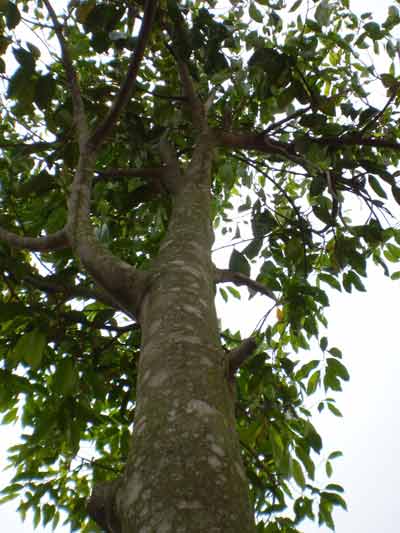Agarwood Incense – Interesting Information
Agarwood Incense – Interesting Information AGARWOOD or Aloeswood
1) This oil is water distilled from fungus infected wood of the tree Aquilaria Agallocha, growing in northeastern India. Agar Oil is pale yellow to brownish yellow or dark amber viscous liquid of rich and sweet woody, almost balsamic and with a sweetness similar to that of sandalwood oil.
2) This is a large evergreen tree, 18-21 meters, sometimes up to 40 meters in height, 1.5-2.5 meters in girth, moderately straight with an often fluted stem. The leaves are 5-9 cm. long, thinly coriaceous, oblong-lanceolate, and the flowers are white, green, or dirty yellow in terminal sessile or shortly peduncled, umbellate cymes. The scent that most are familiar with is obtained by water distillation from the oleoresin/wood only after this tree has been infected with a fungal infection. Non-infected trees do not produce the highly fragrant oil or wood. This tree is found in various Southeast Asian forests, Bangladesh, Bengal, Bhutan, Burma, China, Vietnam and Cambodia. The scent is reminiscent of vetiver and sandalwood and is extremely long-lasting. It is important for us to note that the infected tree must be at least 50 years old to produce the oil.

3) Also Known As -Aloes Wood, Eaglewood, Oud, Ud, Gaharu, Wood Aloe.
4) Properties – Relieves spasm and epilepsy, inhibits the central nervous system, antibiotic, relieves pain, calming, anti-asthmatic, aphrodisiac.
5) Uses – Traditional medical uses for this product include: asthma, chest congestion, colic, diarrhea, diuretic, kidney problems, nausea, thyroid cancer, lung tumors and as a general tonic in China. In Indian Ayurvedic medicine it has been used as a cardiac tonic and carminative (relieves gas from the intestines). There is some belief that this oil may be useful in treating lymph system disorders, high blood pressure and as an anti-malarial treatment due to its chemical composition and components. It is felt that because of the difficulty in receiving this oil, alternative medicine practitioners have not investigated it. It is non-sticky and can be applied directly to the skin or can be thinned in jojoba oil. This is one of the most precious and expensive of essential oils and is truly amazing. It should be experienced by any connoisseur of essential oils. You only need to use a tiny amount of this oil at a time; be prepared for the slow release of its aroma over the next 12 hours. There is no other known oil that is this tenacious.
6) Blends with – The warming, balancing, purifying, deep woodsy, and transcendent qualities of this most unique oil blends well with Carnation, Geranium, and Sandalwood.
7) It has long been an olfactory prize for discerning noses. Agar oil , is highly valued and universally prized as ‘Otto of Roses”. Agar though little known in Assam and the North –East is a highly sought after comodity, and the premiums it commands today in the international markets has dramatically transformed the lives of families and economies of areas where its trade exists or where it is procured. One such area that has reaped and flourished from this wonderful resource is the Hojai Sub-division of Nagaon district.
8) The use of agaru is prehistoric.The aromatic Aloe wood mentioned in the Bible was no other but the heartwood of Aquilaria ovata ,or agar. There is mention of the use of Aloe wood(udul-Hind) in Paradise as incense in the famous Ahadith-Sahi Al-Bukhari.Agar also finds a place in the travelouges on ancient Kamrup by Chinese pilgrim Hiuen-Tsang, besides earning a mention in Abhijnanmam Shakuntalam of Kalidasa and Arthashastra of Chanakya.
9) Agar is inextricably linked to Assam’ s rich cultural heritage. In antiquity, Assam’ s monarchs employed the used bark of the Sasi Agar tree for chronicling their royal circulars and diktats.
10) The first historical bigraphies in Sanskrit –the Harsha Charita written by Bana in 652 AD also chronicles the fact that among the many gifts sent by Assamese king Bhaskara Varman to Harsha,volumes of fine writing in leaves made from aloe bark and balck aloe oil occupied a very prominent place. The Nowgong grant of Balavarman gives a graphic desciption of Pragjyotishanagara where areca nuts are wrapped in leaves of creeper of betel-plants and Krishnaguru(telegu for Agarwood) or black aloe wood trees were surrounded with cardamom creepers. It is also recorded that after conquering the last king Gaur Gobind in 1348AD, in Sylhet, Saint Fakir Ali Shah Jalal and his followers found agar wood and agar attar along with many other valuables in the royal store. This clearly indicates that distillation of agar oil was done as far back as 13th century or even much earlier.Abul Fazal Allami in his Ain-I-Akbari (memiors of Emperor Akbar written in 1590 AD gives a vivid description of agarwood and agar oil along with their manufacturing process and uses.It is also said that the Mughals invaded Assam mainly for agaru..such was it lure!
11) Revered Vaishnava saint – reformer and literary giant Sri Sankardeva, Vaisnavite saint Shri Madhab Deb also used sheets of the Agar for giving a written expression to their sermons, widely using agar for their sacred scriptures. Sri Sankardeva is also believed to have said that agar and chandana are the two divine trees capable of fulfilling human desires. Religious puthis and history was also written and copied on specially treated bark of agar trees, known since time immemorial as Sanchipat and puthis, numerous puthis some dating back to as far back as 500 years ago are still preserved in quintessentially Assamese sacred repositories such as Than, Satras and Namgarh.
12) It is nothing but a rare fungus that attaches itself to the agar tree that has made agar such a valuable and sought after product. This fungus once it establishes itself on the tree turns the woody trunks into a deep brownish black colour. The darker the woody bark turns due to fungal infection, the more valuable the wood It is the fungus that gives the agar wood its unique aroma, when it is burnt. The oleoresin is usually found where the branches fork out from the stem. Agaru or agarwood is the heavily olereosin impregnated solid chips of wood obtained and processed from the fungus affected part of the trees. Devoid of the fungus, the agar tree in itself has no value. So it is natures value addition to the tree that commands a premium in the market.
13) The uses of Agar are many. Its aromatic bark popularly known as Agar Batti is used as incense in many a home. Its by-product Agar oil used as a base for Attars and perfumes. The heavy base notes of the Agar oil lends itself to blend well with other essential oils such as rose, ylang ylang, and jasmine that collectively power the perfume industry, the world over. Some European perfume houses especially seek out Agar oil to create heavier muskier perfume that have enhanced Agars demand and thereby carved a special niche market for these agar dependant perfumes.
14) Agar Oil also has therapeutic uses as it is used in a large number of Unani and Ayurvedic medicines. Interestingly agar is also used to flavour common and widely used betel nut prepartions such as Pan Parag and and Baba Zarda.
15) In Hojai is sold at a rate of 100-6000 rupees per tola or 11.62 grams. In economic terms, its value is pegged at one and half times the price of gold.
16) Once the Agar wood is procured, it is classified on the basis of quality. The less darker pieces are put into larger water drums to soften.
Once these wood pieces soften, they are ground into a powder and are put into vessels called Degs with water. Degs are then heated so as to encourage the ground agar to release the oil within it. Once the water inside the Deg reaches a certain boiling temperature then the oil from the wood along with the water vapour reaches a container called the vabka. Before reaching the vabka the water vapour that passes through a steel pipe between the Deg and the vabka is cooled what therefore reaches the Vabka is a combination of water and agar oil, with the oil floating over the water. This oil is carefully extracted with a fine syringe and then stored into a fine glass bottle to be sun-dried for the final product – the Agar Oil.
17) The need for research into this dwindling valuable resource is compelling. Except in Nagland, there is no Agar left in India. Traditional sources are drying up. Reserves in Kalibanthan and Salabasi in Indonesia are also diminishing day by day. Fortunately for traders new sources have been discovered in Maraoca near Indonesia and Pupua New Guinea, Laos and parts of Java.

